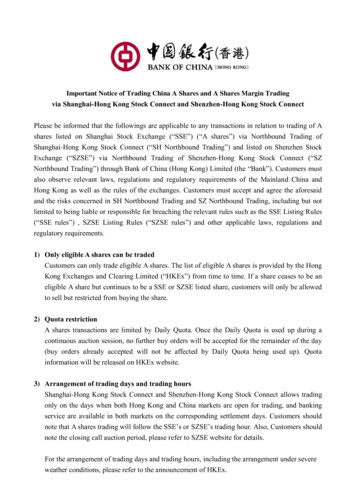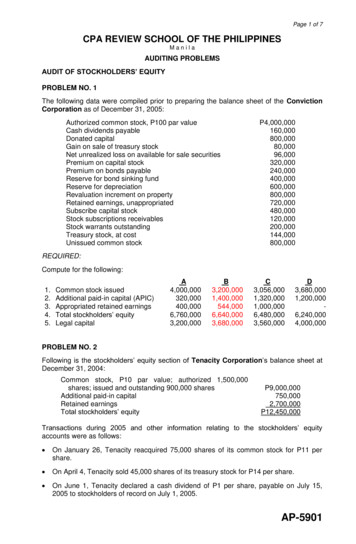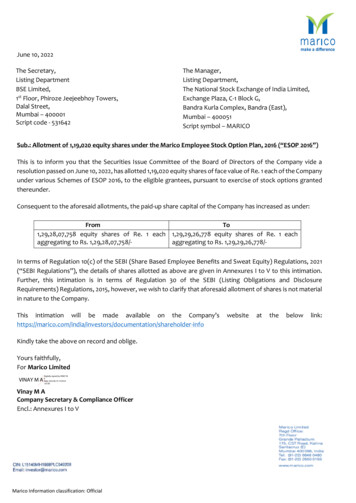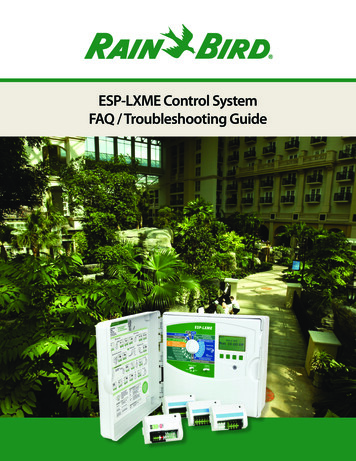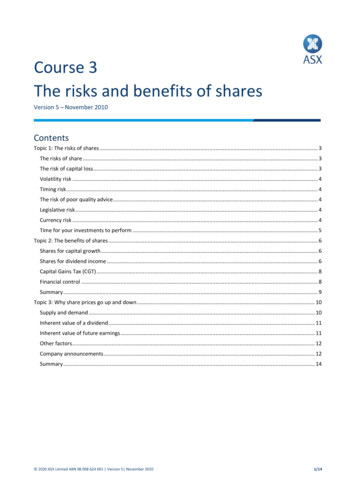
Transcription
Course 3The risks and benefits of sharesVersion 5 – November 2010ContentsTopic 1: The risks of shares . 3The risks of share . 3The risk of capital loss . 3Volatility risk . 4Timing risk . 4The risk of poor quality advice . 4Legislative risk . 4Currency risk . 4Time for your investments to perform . 5Topic 2: The benefits of shares . 6Shares for capital growth . 6Shares for dividend income . 6Capital Gains Tax (CGT) . 8Financial control . 8Summary . 9Topic 3: Why share prices go up and down . 10Supply and demand . 10Inherent value of a dividend . 11Inherent value of future earnings . 11Other factors . 12Company announcements . 12Summary . 14 2020 ASX Limited ABN 98 008 624 691 Version 5 November 20101/14
Information provided is for educational purposes and does not constitute financial product advice. You should obtainindependent advice from an Australian financial services licensee before making any financial decisions. Although ASXLimited ABN 98 008 624 691 and its related bodies corporate (“ASX”) has made every effort to ensure the accuracy ofthe information as at the date of publication, ASX does not give any warranty or representation as to the accuracy,reliability or completeness of the information. To the extent permitted by law, ASX and its employees, officers andcontractors shall not be liable for any loss or damage arising in any way (including by way of negligence) from or inconnection with any information provided or omitted or from any one acting or refraining to act in reliance on thisinformation. Copyright 2010 ASX Limited ABN 98 008 624 691. All rights reserved 2010.All Ordinaries , All Ords , AllOrds , ASX , ASX100 , CHESS , ITS are registered trademarks of ASX Operations PtyLimited ABN 42 004 523 782 ("ASXO").ASX20 , ASX50 , ASX200 , ASX300 are trade marks of ASXO.S&P is a trademark of Standard and Poor’s, a division of The McGraw-Hill Companies Inc. 2020 ASX Limited ABN 98 008 624 691 Version 5 November 20102/14
Topic 1: The risks of sharesThe risks of shareInvestors should be aware of the risk/reward relationship thatexists with any type of investment. In order to receive a returnon money invested you need to be prepared to place thatmoney 'at risk'. Generally the greater the risk associated withan investment the greater the rate of return investors willexpect.The risk of capital lossAn investment in the sharemarket is by no means a guaranteedinvestment. Investors are able to redeem the value of their shareinvestment by trading those shares via the sharemarket.When a company is performing poorly it may be difficult to find abuyer for your shares at the price you want to sell them. As a resultthe sale price of your shareholding may be considerably lower thanits original purchase price. What happens if you own shares in acompany that fails?In the event that the company you own shares in goes out ofbusiness, its shares will no longer be tradable on the sharemarket.When a company is removed from the list of companies whoseshares are tradable on ASX that company is said to have been'delisted'.If a company you own shares in has been delisted the only way toclaim back your money is if a liquidator has been appointed andshareholders receive a portion of the sale of the company's assets.In the event of asset liquidation, shareholders are last in the list ofother creditors (e.g. banks, other lenders, suppliers) to receive anyfunds that may be realised.As a result shareholders may receive only a fraction of their originalinvestment amount or could face the prospect of the complete lossof the amount they invested in the shares of that company. 2020 ASX Limited ABN 98 008 624 691 Version 5 November 20103/14
Volatility riskShare prices can rise and fall rapidly and investors must accept the fact that the value of their shares may fluctuate byas much as 50 per cent or more in a year. General market risk can relate to a particular sector, e.g. mining shares areusually more volatile than industrial shares such as bank shares. Specific risk can relate to the performance of anindividual share.Timing riskBecause of market cycles, some shares have a higher degree of risk when the overall sharemarket has risen sharplyand is set for a reaction. The opposite may apply when the market has gone into a strong decline and then starts torecover after showing some signs of stabilising. Not all sectors of the market follow the same price cycles.Understanding business cycles and how different companies perform during the different phases of the business cyclecan help to manage the effects of timing risk.The risk of poor quality adviceAre the investment recommendations made to you supported by a thoroughly argued case, or are they merelyhearsay? The more reliable information you have, the better your decisions will be. Adopting a disciplined decisionmaking process will help you to minimise losses while you patiently build a portfolio.Recommendations involving high rates of investment return can fail to produce satisfactory results when taxation,ongoing fees and constant changes in investment cycles affect the performance. ASIC has some excellent informationon getting financial advice on their website.Legislative riskYour investment strategies or even individual investments could be affected by changes to the current laws.Currency riskIf you have overseas investments, adverse moves in the currency need to be considered. This is because when youbring your profits home they need to be converted from the foreign currency into Australian dollars. 2020 ASX Limited ABN 98 008 624 691 Version 5 November 20104/14
Time for your investments to performIt takes time to learn to invest effectively. Time to learn about your investment alternatives, time to make investmentdecisions and time to manage your investments thereafter. Many people feel it is easier to invest in some areas, suchas the cash market, than in other areas such as property and the sharemarket.Depending on the amount of time you have and your level of interest, you have the choice of making all your ownsharemarket investment decisions, relying more on the advice of your stockbroker or making an indirect investmentthrough a reputable fund manager.Of course, investment decisions become easier as you gain experience and learn more about the factors affecting yourinvestment. These are just some of the risks that are associated with an investment in the sharemarket. Learningabout risk and its effect on your investments is crucial. You should clearly understand the risks associated with anyinvestment you are considering. 2020 ASX Limited ABN 98 008 624 691 Version 5 November 20105/14
Topic 2: The benefits of sharesShares for capital growthCapital growth occurs when the value of your investment increases. Many people invest for capital growth to buildtheir wealth and protect themselves against inflation.People invest in shares because they offer the possibility that their price will rise. Owning shares in a company with arising share price is one way to achieve capital growth.Capital growth is essential to investors as long as there is inflation. Inflation is a measure of the rise in the price ofgoods. The Reserve Bank of Australia (RBA) aims to keep inflation within a range of 2-3%. With no capital growth, yourmoney will buy less in the future than it does now.The graph opposite shows the impact inflation can have on eroding the future purchasing power of money. In thisexample, if inflation is at 3% per annum, 10,000 will have only half its purchasing power in 10 years’ time.Shares for dividend incomeA dividend is the distribution of a company's net profit to shareholders. Dividend yields vary greatly from company tocompany. It is not compulsory for a company to pay a dividend.For Australian investors, dividends are often worth more than the cash payment they receive. This is because acompany can also distribute franking credits for any company tax it has paid. 2020 ASX Limited ABN 98 008 624 691 Version 5 November 20106/14
Franked dividends carry imputation credits, which entitle shareholders to a tax offset or a reduction in the amount oftax to be paid. If your marginal rate of tax is lower than the company tax rate, the excess franking rebate can be usedto reduce the tax payable on other sources of income.In addition to rising share prices, dividend re-investment plans (DRP) can multiply the capital growth effect of a shareinvestment. DRP is an alternative to cash dividends, allowing shareholders to purchase new shares instead of receivinga cash dividend. These shares are often issued at a discount to the current market price and no brokerage is paid. 2020 ASX Limited ABN 98 008 624 691 Version 5 November 20107/14
Capital Gains Tax (CGT)Shares enjoy good taxation benefits in comparison to most other investments. You realise a capital gain whenever yousell shares and the consideration received (sale price less related costs such as brokerage) is more than the cost base(purchase price plus related costs).If the shares were acquired on or after 20 September 1985, the capital gain must be included as assessable income inyour tax return and is subject to CGT. CGT is payable at your marginal tax rate in the year in which you sell the shares.For shares acquired on or after 21 September 1999 and sold 12 months or more after the date of acquisition, capitalgains may be discounted by 50%; meaning only half of the capital gains must be included in your assessable income.The Australian Tax Office (ATO) is the source of knowledge for all tax related matters. For the most up to date taxinformation, please visit their website www.ato.gov.auFinancial controlShares' flexibility and liquidity are key advantages. In particular, the ease and low cost involved in buying and sellingrelatively small amounts and the control that gives you; whether to free up some cash, rebalance your portfolio orsimply realise a profit. 2020 ASX Limited ABN 98 008 624 691 Version 5 November 20108/14
Many people appreciate how easy it is to invest in shares. There is no conveyancing cost, stamp duty or ongoingexpenses. You can do everything over the internet if you wish, and brokerage fees are much lower than typical realestate agent fees. So you can start small, buying companies you know, and take the time to learn as you go.We will look more closely at the process of buying shares in the course, 'How to buy and sell shares'.Summary Shares present risks and benefits.The chief risks being capital loss, price volatility and no guarantee of dividends.Benefits of shares include the opportunity for capital growth, dividend income, flexibility and control. 2020 ASX Limited ABN 98 008 624 691 Version 5 November 20109/14
Topic 3: Why share prices go up and downThe price of anything that can be bought or sold is unpredictable to some extent. Many factors can simultaneouslyaffect values both positively and negatively over different periods of time. However, the impact of many individualfactors is sometimes quite predictable so it can pay to consider them since that is what many other investors will bedoing.You should think in terms of factors that affect each of the following: Supply of and demand for the sharesThe inherent value of the sharesOther less direct influences on share prices.Supply and demandThe sharemarket is a market place like any other. The forces of supply and demand determine the price of shares. Themore people want to get hold of a particular share, the higher its price will go. If people no longer want a share andfew people are willing to buy it, people may have to offer it at a very low price in order to sell it.Supply and demand for shares is influenced by some of the factors outlined below. 2020 ASX Limited ABN 98 008 624 691 Version 5 November 201010/14
Inherent value of a dividendDividends provide immediate and concrete value to shareholders so a share that pays dividends has inherent value.For this reason, the price of a share will often fall by approximately the dividend amount when the share goes exdividend (Ex-dividend date: Shares are quoted 'ex-dividend' four business days before the company's record date, andwill remain 'ex' for five business days. Normally to be entitled to a dividend a shareholder must have purchased sharesbefore the ex-dividend date (or buy them cum after the ex)). You should assess a company's ability to pay dividends orprovide capital growth in the future; in particular, what are its expectations of future earnings?You can read more about ex and cum status on the status notes page on the ASX website.Inherent value of future earningsThe most important factor affecting the price of a share is the company's future earnings prospects, as its earnings willdetermine the future inherent value of a share. Any changes in forecast earnings, either by company management orby market analysts, will impact the share price.Past earnings, as can be found in the company's annual report, are an important indicator of a company's earningsability, but you should also consider the impact of any changes to its business. 2020 ASX Limited ABN 98 008 624 691 Version 5 November 201011/14
For example, how will it be affected by a change in senior management, new efficiency measures, productinnovations, industrial action or the acquisition of another business?Other factorsA range of economic factors both in Australia and overseas affect share prices. In assessing these factors you shouldavoid getting caught up in the short-term reaction to announcements of economic data (or short-term marketvolatility) but instead think of the direction of price trends and whether prices might be expected to turn around.Australian share prices are affected by the following Australian economic factors: Overall economic growth (prefer steady or strong)Level of unemployment (prefer low but not too low or wages will rise – excessive wages growth can triggerinflation)Consumer confidence (prefer high as long as borrowing is not out of control)Spending (by consumers, businesses and governments can boost profits)Inflation (high retail prices can dampen the economy), andThe value of the Australian dollar (affects individual companies differently: a rising currency can benefit importersbut disadvantage exporters).Because Australia is part of the global economy, Australian share prices are also affected by economic conditionsoverseas. Movements on overseas exchanges can have flow on effects to our domestic market.This is a result of Australian company reliance on overseas markets for a portion of their profits. The globalisedeconomy allows the funds of overseas (and Australian) investors to flow rapidly into and out of the Australiansharemarket as conditions change.Company announcementsKeeping up to date with the information about a company you have shares in is very important. Companyannouncements are the main communication channel between listed companies and the market. Companyannouncements are notices sent electronically to ASX and published live on the ASX website.ASX listed companies are obliged to inform the market of their activities, especially any information that might have amaterial effect on the company's share price. 2020 ASX Limited ABN 98 008 624 691 Version 5 November 201012/14
A company announcement marked with a red exclamation indicates that the announcement is "price sensitive". In thiscase trading in that company's shares will be put on hold for a minimum of 10 minutes to allow investors to read anddigest the contents of the announcement. 2020 ASX Limited ABN 98 008 624 691 Version 5 November 201013/14
Summary Any investment in the sharemarket carries a degree of risk. It is possible to make a complete loss of capital with anyinvestment.Carefully consider the range of risks that an investment in the sharemarket can present including market risk, pooradvice, timing risk, currency risk with overseas investments.People invest in the sharemarket to achieve certain financial goals, most commonly, capital growth and dividendincome.Consider the benefits of concessional capital gains tax and franked dividends when assessing an investment in thesharemarket.Share prices are determined by the forces of supply and demand.The price you see in the market is the last traded price and it is where the buyer and seller of shares have cometogether and agreed on a price.There are a wide range of factors that drive investor demand for a share. These can include the company'sprofitability, how its competitors are performing, any legislation that government may introduce, how overseasdemand for its products may evolve.It is important to learn about both the broad economy and the specific company you are investing in.You can learn more about a company by reading the Company Announcements it releases on the ASX website. 2020 ASX Limited ABN 98 008 624 691 Version 5 November 201014/14
expenses. You can do everything over the internet if you wish, and brokerage fees are much lower than typical real estate agent fees. So you can start small, buying companies you know, and take the time to learn as you go. We will look more closely at the process of buying shares in the course, 'How to buy and sell shares'. Summary



